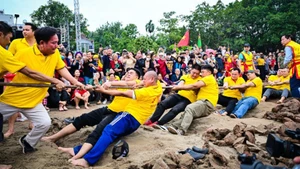Quang Ninh is one of the continuous residences of ancient Vietnamese people. From about 5,000 to 3,500 years ago, the owners of Ha Long Culture moved out to occupy and exploit the coastal plains and islands. Ha Long Culture with very unique characteristics, is the largest in Vietnam and is located in the pivotal period from prehistory to history, its mark is not only seen in the coastal area of Quang Ninh but also in Hai Phong and some neighbouring coastal areas with three successive prehistoric cultures that developed for more than ten thousand years: Soi Nhu Culture, Cai Beo Culture, and Ha Long Culture.
Archaeological evidence, sites, and artifacts of the Cai Beo Culture discovered by French archaeologist M. Colani in 1938 showed that, in order to survive in the island environment, the Cai Beo Culture residents created a set of stone tools (axes, adzes) with sharp tips suitable for exploiting oysters, barnacles, processing bamboo and wood products, and building rafts.
In addition, there were net sinkers, grinding pestles, and grinding tables for fishing and food processing. In the Cai Beo relic, hundreds of tons of sea fish bones were collected, including sharks, blue parrotfish, and sawfish. The Cai Beo Culture was the source of the later Ha Long Culture in the northeastern sea of Vietnam.
The Ha Long Culture belongs to the late Neolithic period to the early Metal Age, dating from about 6,000 to 3,500 years ago, expressed through a diverse system of relics, a rich system of artifacts, and new developments in the techniques of making stone tools, jewellery, and pottery. Typical stone tools and jewellery include: axes, shouldered adzes, notches polished all over the body, bracelets, porous pottery decorated with additional patterns, S-shaped and wave-shaped carved patterns, and U-shaped grooved tools.
The unique feature that creates the mark of Ha Long Culture on Quang Ninh land is the unique maritime culture, clearly expressed from its roots in the system of maritime culture at the same time in Vietnam, shaped by the sea, exploiting the sea, living with the sea to serve life. The owners of Ha Long Culture knew the sea travel industry and the sea exploitation industry from a distance more skilfully than other sea cultures of the same period in Vietnam, such as: Hoa Loc Culture in Thanh Hoa, Bau Tro Culture in Quang Binh, and Xom Con Culture in Khanh Hoa.
Ha Long Culture features many rich types of relics, such as: cave residence relics, outdoor residence relics, and burial relics on diverse terrains. In Quang Ninh, there are currently 30 sites belonging to Ha Long Culture discovered. Ha Long Culture was developed through two stages: the early stage (5,000-4,000 years ago) and the late stage (4,000-3,500 years ago).
Ha Long residents are residents of a sea culture. The existence and development of sea residents has always been very dynamic in cultural exchanges, integration and adaptation in prehistoric times. Not only that, Ha Long culture also left its mark on the early Bronze Age cultures in the northern mountainous provinces, especially the midland of the Red River Delta, as well as the coastal plain of the Ma River.
On the contrary, these cultures had a significant impact on Ha Long Culture, as evidenced by the Phung Nguyen Culture at the Bo Chuyen site (Dai Yen, Ha Long City), and Dau Ram (Hoang Tan, Quang Yen Town). Having had horizontal and vertical exchanges with major cultural centres at that time, Ha Long Culture residents promoted their internal strength, stood firmly on their maritime cultural foundations, promoted the strengths of river residents, and took advantage of the achievements of the delta residents to contribute with other communities to the ancient Vietnamese civilization, later creating the Van Lang - Au Lac nation.
 |
| Cheo singing on Ha Long Bay is a form of antiphonal singing, usually collective singing between men and women, commonly seen in other love affairs in the North. |
From a life adapted to the sea, fishermen have developed the need to express their thoughts and feelings towards the sea, their homeland and loved ones, leading to the birth of folk-art works. The folk works of coastal residents are quite diverse, from legends and fairy tales of coastal residents to folk songs and performing arts, such as: love-matching singing on Ha Long Bay (also known as Cheo Duong singing), dum singing, and sea singing.
Many intangible cultural heritages of the island cultural heritage are integrated to make the festival more vivid, such as: Tan An Fishing Festival, Tien Cong Festival in Quang Yen Town, Ba Men Temple Festival, and Giang Vong - Truc Vong Communal House Festival on Ha Long Bay. Festivals in the Ha Long sea area contain many unique and distinctive cultural values imbued with the breath of life of the people of the Vietnamese sea in general.
Archaeological documents in Ha Long are the basis for research on geo-environment and paleoclimate changes in the coastline due to sea encroachment and retreat as well as natural events at sea, and aid in understanding the picture of ethnic languages in the past. Meanwhile, the treasure trove of unique intangible cultural heritage can be built into performing arts products for tourism.
















